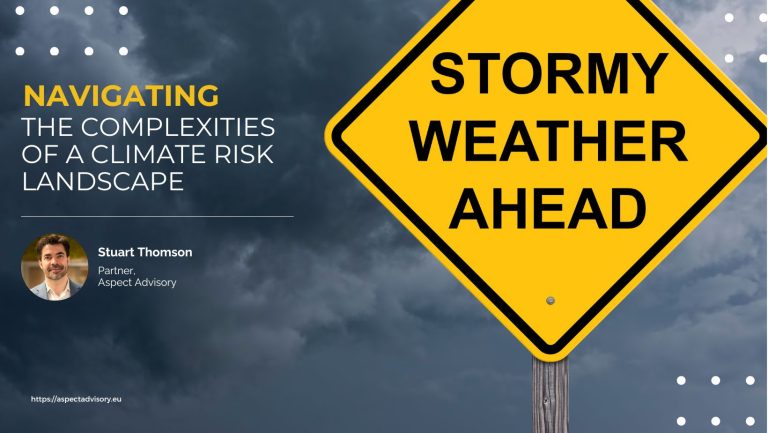
Introduction
With six months and two seasons in 2023 breaking previous records, the global November temperatures particularly stand out. Notably, two days surpassed the threshold of being over 2°C higher than preindustrial levels. Consequently, 2023 has etched its name in the annals of history as the warmest year ever recorded (Copernicus Climate Change Service, 2023). It’s unlikely to stand for long, 2024 has already broken a lot of records within the 1st quarter. The first step in asking “What can we do about it?”, is measurement. That is why the importance of increasing transparency in climate-related risks and promoting stronger resilience and adaptability has become crucial.
Given the escalating necessity to tackle climate change, there is a growing recognition of the pivotal role financial institutions play in incorporating climate change-related risks into their strategic frameworks. The inherent influence of the financial sector on economic activities, predominantly through funding decisions, investment strategies, and risk management, positions FIs as crucial catalysts in addressing climate risk.
In this article, we explore the intersection of climate risk and the financial sector, discussing the growing demand in the climate tool market, the role of artificial intelligence (AI) and the importance of a robust regulatory framework to mitigate these risks.
The Growing Imperative for Climate Risk Management
To effectively address climate risk, it’s become imperative for financial institutions to integrate it into their decision-making processes. Most leading FI’s have started their journey to do this already, however such frameworks need to include forecasted climate risks and opportunities when evaluating investment options, assessing the resilience of their portfolios to climate-related events, and engaging with stakeholders to promote sustainable practices. By doing so, financial institutions can align their activities with the goals of the Paris Agreement and contribute to the transition to a low-carbon economy.
With rising sea levels, increased temperatures, and extreme weather events, physical risks such as property damage, business interruptions, and supply chain disruptions have become a tangible reality.
Furthermore, transition risks arising from decarbonisation efforts, policy changes, and technological advancements pose additional challenges. As the world moves towards a low-carbon economy, companies heavily reliant on fossil fuels may face a significant devaluation of their assets. This transition also presents opportunities for companies involved in renewable energy and sustainable technologies.
It is essential for businesses to accurately assess and manage these risks to safeguard their long-term financial health and to contribute to a sustainable future. Failure to address climate risks can lead to reputational damage, loss of investor confidence, and even regulatory penalties.
The Growing Demand in the Climate Tool Market
The climate tool market has experienced significant advancements in recent years, as the landscape of climate risk assessment undergoes a swift and profound transformation.
Verdantix has determined that the global climate financial data and analytics market had a value of $468 million in 2022 and is projected to increase to over $1.3 billion by 2028, reflecting a Compound Annual Growth Rate (CAGR) of 19%. However, due to the considerable uncertainty brought about by unclear regulations in crucial markets and significant political events anticipated in 2024, the forecast for 2028 encompasses a range between $1 billion and $1.5 billion.
1. Partnerships & Collaborations
In the swiftly shifting landscape of this market, users have witnessed strong collaborations not only among tool vendors but also spanning diverse industries. These initiatives are prompted by the realisation that collaboration is imperative for effectively tackling complex challenges. When it comes to climate risk tools, partnerships among tool vendors and across various industries can generate substantial benefits, such as cross-industry expertise, data sharing and integration, innovation and technology transfer, market adoption and standardization, etc.
2. Regulatory Compliance and Stress Testing
In the midst of the regulatory and disclosure landscape concerning climate-related risks and opportunities as elaborated earlier in this article, financial institutions are experiencing mounting demands stemming from mandated reporting, driven by regulatory requirements.
To effectively manage climate risk and comply with evolving regulatory requirements, financial institutions are leveraging emerging functionalities and technologies. These functionalities provide advanced analytics, scenario modeling, and data visualisation capabilities to assess, monitor, and report climate-related risks.
- Climate Risk Assessment Tools:Financial institutions can rely on specialised software platforms and tools that help assess and quantify climate risk across various dimensions, including physical risk, transition risk, and liability risk. These tools often combine climate data, economic data, and financial data to provide comprehensive risk assessments and scenario analyses.
- Data Integration and Analysis:Financial institutions are leveraging big data analytics and machine learning to integrate and analyse vast amounts of data from diverse sources. This enables them to identify correlations, trends, and patterns, improving their understanding of climate risk exposure and enhancing their risk management strategies.
- Scenario Modeling and Stress Testing:Advanced modeling techniques are being used to simulate climate-related scenarios and assess their impact on financial institutions’ portfolios and balance sheets. Scenario modeling helps institutions understand the potential financial implications of different climate scenarios and aids in decision-making, resource allocation, and risk mitigation strategies.
- External Data and Research:Financial institutions are increasingly relying on external data sources and research to enhance their understanding of climate risk. This includes leveraging climate models, scientific research, and industry reports to validate internal assessments and improve risk modeling and stress testing frameworks
In January 2024, UNEP FI’s Climate Risk and TCFD Programme have recently updated the Climate Risk Tool Dashboard, offering valuable assistance to financial institutions in navigating the ever-changing landscape of climate risk tools.
The Role of Artificial Intelligence (AI)
As the financial sector grapples with the increasing impact of climate change on investment portfolios and business operations, AI has emerged as a powerful tool in evaluating, quantifying, and managing climate risks. AI algorithms can analyse vast amounts of data from diverse sources, enabling businesses to assess the vulnerability and potential impacts of climate risks more accurately.
For instance, machine learning algorithms can process climate model projections, historical weather data, satellite imagery, and socioeconomic indicators to generate comprehensive risk profiles. This can assist financial institutions in identifying climate hotspots, assessing asset exposure, and stress testing portfolios under various climate scenarios.
Furthermore, AI-powered tools can enhance the accuracy of climate-related financial disclosures. By automating data collection and analysis, financial institutions can provide investors and stakeholders with more reliable and transparent information on climate-related risks. This promotes better risk pricing, informed decision making, and fosters trust among market participants.
The Importance of a Robust Regulatory Framework
While AI can greatly assist financial institutions in managing climate risks, a robust regulatory framework is essential to ensure consistent and comprehensive risk management practices across the industry. Regulators play a pivotal role in setting transparency standards, stress testing requirements, and promoting effective risk governance.
The past year witnessed significant advancements in global standards and regional approaches regarding disclosures, stress testing, and greenwashing with regards to climate risks. These developments underscore the necessity for further transparency and reinforced resilience within the financial system.
Upcoming sustainability reporting regulations within the EU to monitor in 2024:
- EU green claims directive: These regulations aim to combat greenwashing by stipulating that environmental claims made on products must be transparent, accurate, and supported by evidence.
- EU regulation on deforestation-free products: This legislation imposes stringent responsibilities on companies that import key commodities such as soy, beef, palm oil, wood, cocoa, and coffee. These companies are required to conduct thorough due diligence to ensure that the production and trade of these products do not contribute to deforestation or forest degradation, thereby promoting sustainable business practices.
- Revision of EU legislation on packaging and packaging waste: A milestone update has been introduced, which necessitates a comprehensive reevaluation of packaging standards. The aim is to enhance recyclability, minimise waste generation, and encourage the widespread adoption of reusable packaging solutions. The EU aspires to achieve an ambitious target of making all packaging within the EU fully recyclable by 2030.
- EU “women on boards” directive: This directive represents a groundbreaking step towards achieving greater gender equality in leadership roles. It mandates that significant representation of women be ensured in leadership positions within various organisations.
In June of 2023, the International Sustainability Standards Board (ISSB) unveiled its first-ever sustainability disclosure standards, which encompass IFRS S1: General Requirements for Disclosure of Sustainability-related Financial Information and IFRS S2: Climate-related Disclosure Standard. Operating under the supervision of the IFRS Foundation, the ISSB will assume responsibility for overseeing TCFD monitoring starting in 2024. The new framework is slated to serve as the universal standard for climate-related disclosures.
As the financial industry navigates through the complexities of the climate risk landscape, collaboration between regulators, financial institutions, and other stakeholders is crucial. By establishing a harmonised and robust regulatory framework, we can promote climate resilient financial systems that are better equipped to respond to the challenges posed by climate change.
Conclusion: Building Resilience in the Face of Climate Risks
Identifying, measuring and monitoring Climate risk, as the new primary threat to doing business in the financial sector, presents a range of obviously complex and evolving challenges. As the world grapples with the impacts of climate change, and how to slow down the driving force behind them, financial institutions must proactively manage and adapt to these risks and changes. By leveraging AI technologies, financial institutions can enhance their risk assessments and disclosures, enabling better decision-making and risk management. Nevertheless, a comprehensive regulatory framework is necessary to establish consistent practices, promote transparency, and safeguard the stability of the financial system. Together, through collaboration and innovation, we can navigate the complexities of the dynamic climate risk landscape and build a more resilient financial sector for the future and the planet.
Aspect Advisory appreciates the significance of climate change not only as an environmental issue but also as a crucial financial imperative. We possess the expertise to provide data-driven solutions and establish extensive global alliances, enabling us to identify and empower financial institutions to flourish amid ever-changing environmental challenges. Our sophisticated climate risk stress testing and modeling methodologies allow us to guide our clients effectively, assisting them in evaluating both physical and transitional climate hazards.
Sources:
- Climate Risk Landscape 2024: https://www.unepfi.org/wordpress/wp-content/uploads/2024/04/Climate-Risk-Landscape-2024.pdf
- Emerging EU Regulations: https://plana.earth/academy/eu-esg-regulations
Contact us

Stuart Thomson
Partner,
Aspect Advisory
![]()
